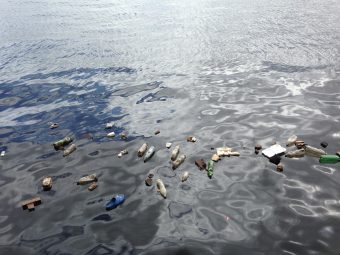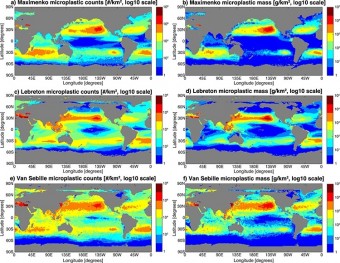
The 5 Gyres Institute co-authored this study which is the most comprehensive estimate of small plastics in the world’s oceans. There were two other papers published earlier, one by Cozar (2014) and Eriksen (2014) using separate data sets.
The paper published last week in Environmental Research Letters, A Global Inventory of Small Floating Plastic Debris, uses three ocean models and every dataset published since the 1970s. With 10 authors contributing to it, it’s the best so far. This new study suggests there are 15 to 51 trillion microplastic particles in the world’s oceans, weighing somewhere between 93 and 236,000 metric tons. This is roughly seven times more than what we thought before.
 Why is it more? It has more data and more recent data. It combines the efforts of three different ocean models, so the resolution is a lot better. There’s also a lot more plastic in the ocean. Consider that in 2013 the plastics industry reported 300 million metric tons of new plastic produced in that year and a lot of it used for single-use throw away products sent to countries that have poor waste management. That combo is a recipe for trashed seas.
Why is it more? It has more data and more recent data. It combines the efforts of three different ocean models, so the resolution is a lot better. There’s also a lot more plastic in the ocean. Consider that in 2013 the plastics industry reported 300 million metric tons of new plastic produced in that year and a lot of it used for single-use throw away products sent to countries that have poor waste management. That combo is a recipe for trashed seas.
What is the end game for all of the plastic out there? Research shows that if we can turn off the tap, most of it will sink or wash ashore. The ocean is very dynamic and turbulent, constantly throwing things out, tearing it apart and sinking it. Humanity will have to live with this geologic layer on the ocean floor and beaches worldwide. Call it the Plasticene. Plastic is the index fossil that marks in geologic time that humans were here.
What can we do about it? We’ve got to turn off the tap using two big ideas.
1. Waste management around the world must improve and that means getting away from burning and burying our waste. Diverging waste to responsible management schemes, like compost facilities and recovery and recycling, must improve.
2. Product design is a mandatory part of the solution. The single use throwaway product concept is trashing our oceans. No waste management scheme is going to effectively clean up the proliferation of poorly designed products and packaging, like plastic bags, plastic straws, microbeads, water bottles, etc.
These two solutions—waste management and product design—must happen simultaneously. We cannot expect countries to take out huge loans to pay to improve their waste management. It would be grossly unfair to create that economic burden, while the poorly designed products and packaging continue to trash our land and sea. We need the plastics industries that make and manufacture single-use throw away products to step up and design for a better future.
Source: www.ecowatch.com
Photo: www.5gyres.org

